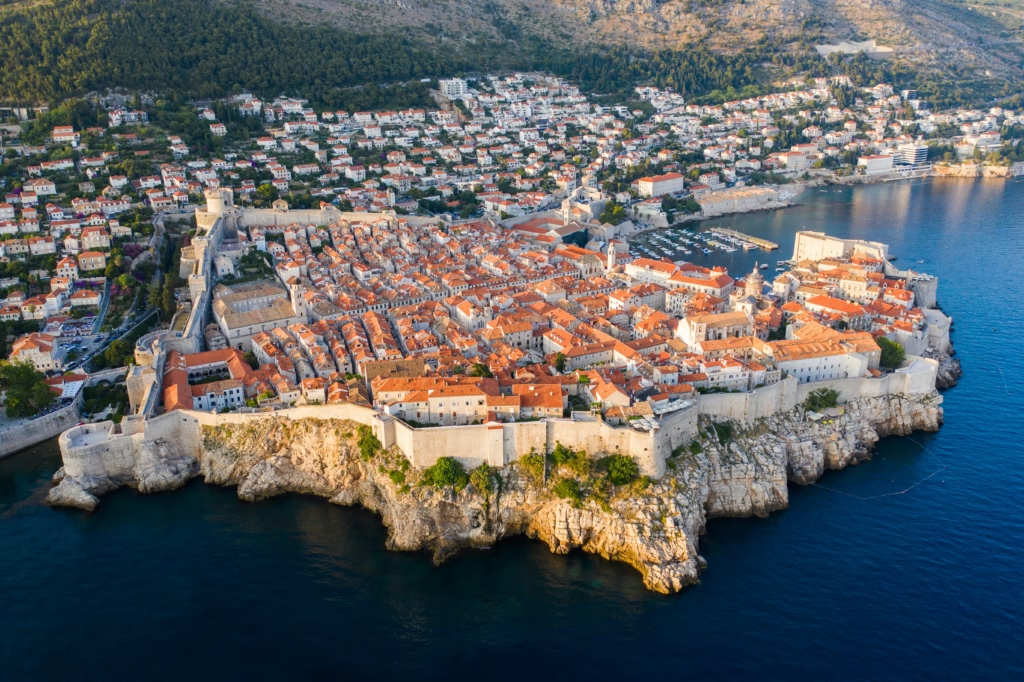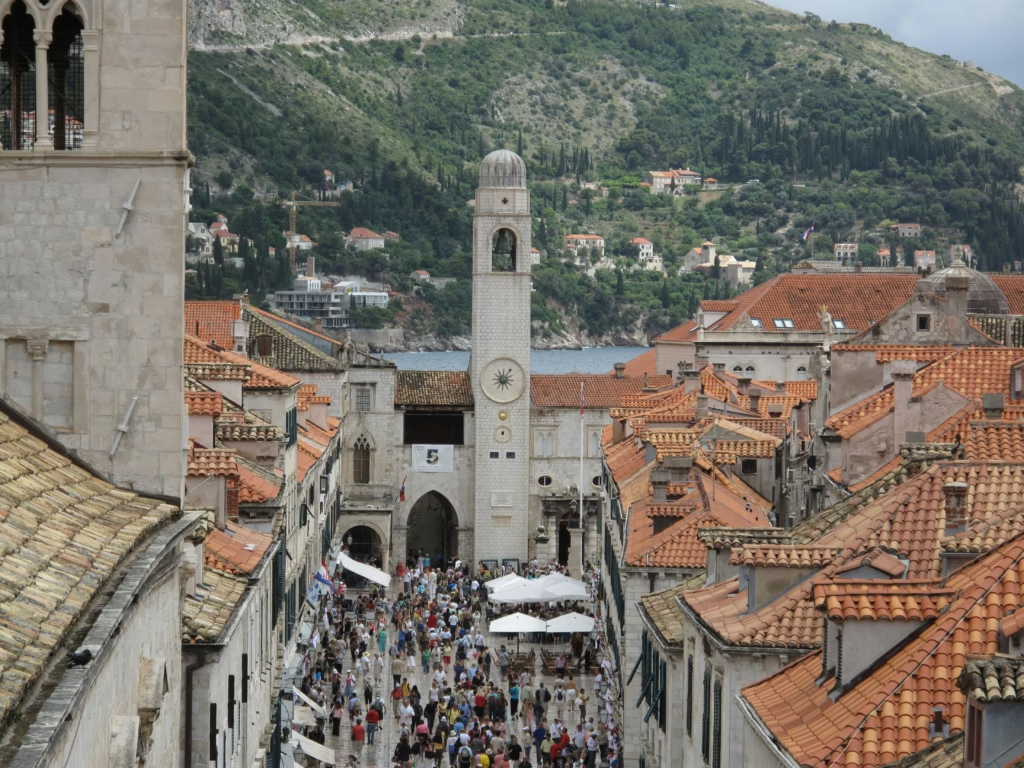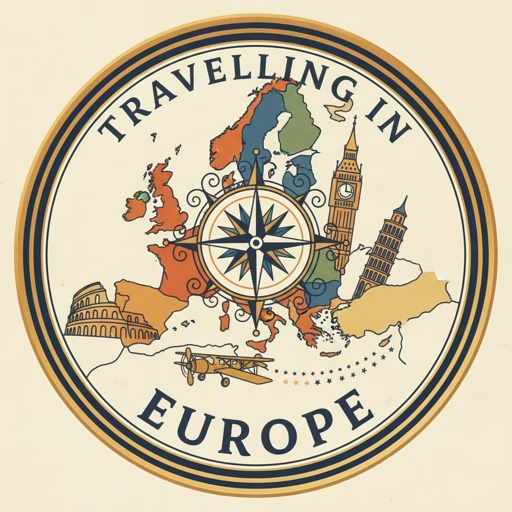Dubrovnik, Croatia — A tourist guide

(witty, slightly romantic, and practical — for people who want history with their honeymoon and seafood with their sunset)
Dubrovnik is the kind of city that looks as if someone polished the Middle Ages and set it afloat on the Adriatic. Its orange roofs, marble promenades, and fortress walls hug the sea in a way that makes romantic clichés feel underdressed. But beyond the postcard: there’s gorgeous food, stirring history, Game of Thrones fan-joy, and surprisingly efficient ways to get around. This guide covers how to arrive (plane or nearby trains), getting about locally, the must-see sights, museum and ticket advice, where to eat (from cheap to luxe), pub and breakfast notes, useful etiquette, how to get a local SIM, and a tidy Perfect 2-Day Itinerary.
Getting there: by plane (and by train-ish)
By plane: Dubrovnik Airport (DBV)
If you’re flying, Dubrovnik’s gateway is Čilipi / Dubrovnik Airport (DBV). In high season many budget carriers fly directly to DBV — think the usual low-cost suspects that serve Europe’s sun routes. If you’re chasing a bargain, check seasonal schedules (spring and autumn have fewer flights).
Practical arrival notes: the airport is a short taxi or shuttle ride from the Old Town — expect 20–30 minutes depending on traffic. Many tour operators and hotels offer transfers; taxis have fixed-ish rates posted at the terminal.
By train: not exactly — the nearest railheads
Important: Dubrovnik has no train station. The closest major rail connections are in Split (Croatia) and Mostar (Bosnia & Herzegovina). From those cities you’ll continue to Dubrovnik by bus, car, or (seasonally) by ferry — an extra leg that turns travel into part of the adventure. If you prefer rails for longer stretches (e.g., Zagreb → Split), plan to switch to bus or ferry for the final hop.
Budget airlines that fly to Dubrovnik
If you’re hunting low fares, search carriers such as easyJet, Ryanair, Vueling, Eurowings and other seasonal operators — routes change by year and season, so compare dates and airports. Off-season you may rely more on national carriers or fewer direct links. Book early for summer; late bookings mean higher prices and fewer choices.
Pro Tip: If you want the earliest/cheapest flights, be flexible on dates and consider arriving in Split or even nearby airports and making the scenic onward trip.
How to get around Dubrovnik
Walking
The Old Town is compact and pedestrianized — walking is the best way to soak in the architecture and feel the city’s rhythm. Expect uneven marble, steps, and narrow lanes; comfy shoes are non-negotiable.
Local buses (Libertas)
Dubrovnik’s public buses (operated by Libertas) connect the Old Town with Lapad, Gruž (the ferry port), and other neighborhoods. Tickets can be bought at kiosks, from drivers (ask first if allowed), or via transport apps; validate where instructed. Buses are frequent in summer but can be crowded during cruise-ship peaks.
Ferries & water taxis
Short ferries link the Old Town to nearby islands and beaches; water taxis are fast (and pricier) for direct transfers. Lokrum Island — a short boat ride — is perfect for a half-day escape.
Taxis & rideshares
Taxis are readily available; always check the meter or ask for an approximate fare before you set off. Some rideshare options exist but are less common than in larger cities.
Pro Tip: If you plan a morning walk on the City Walls, schedule transport for after your walk (your legs will thank you).
Major sights & how to get tickets
The City Walls (must-do)
Walking the full circuit of Dubrovnik’s walls is the top experience: sea views, ramparts, forts and the photographic drama you’ve seen in a thousand travel snaps. Buy tickets online or at official kiosks to avoid queuing; early morning and late afternoon are blissfully less crowded. Many parts are exposed to the sun — bring water and sunscreen.
Fort Lovrijenac (Lovrijenac)
Perched outside the western walls on a rocky outcrop, this fort offers dramatic views and often appears in photography of the city. It’s also one of the Game of Thrones filming spots.
Rector’s Palace & Museums
The Rector’s Palace houses historical exhibits and rotating shows; check opening hours and buy tickets on official museum sites if you plan to visit multiple institutions. Museum opening times vary seasonally — many are busier and open longer in summer.
Cable car to Mount Srđ
For the best panorama of Old Town and the Elaphiti islands, take the cable car to Mount Srđ. Tickets are typically available at the lower station; peak-season prices for a round trip are moderate and the ride is quick. If you want sunset, buy return tickets in time for the last car down.
Lokrum Island
A short ferry ride from the Old Town, Lokrum is a botanical island with peacocks, a ruined monastery, and small swimming coves. It’s also home to a few Game of Thrones filming locations.
Game of Thrones filming locations
Fans will recognize many spots: the City Walls, Fort Lovrijenac, the Jesuit Stairs (Cersei’s walk of shame), and parts of Lokrum among others. Guided GOT tours exist, or you can follow maps that point out the principal sites. Vogue
Best way to buy tickets
- For high-demand attractions (City Walls, Rector’s Palace, cable car), buy online in advance during summer.
- For museums, check official museum federation pages for combo tickets or passes.
- For ferries and island trips, tickets are usually available at the port kiosks (and sometimes online for certain routes).
Museums & cultural stops worth your time
- Cultural History Museum / Rector’s Palace — city history and artifacts. dumus.hr
- Maritime Museum — Dubrovnik’s seafaring legacy.
- Fortress exhibits — many forts have small exhibitions about sieges and local history.
Plan your museum visits by interest and opening hours; many close earlier in low season.
Eat like a local: from schnack to splurge
Breakfast
Croatian breakfasts range from simple coffee and a pastry to a fuller continental spread. For a local experience, try a small café with coffee (“kava”) and a burek (savory filled pastry) or a brioche with jam.
Cheap & cheerful
- Konobas and seaside fish stalls: fresh grilled fish, small plates, and local wines — wallet-friendly if you choose local menus rather than tourist set-menus.
- Bakeries & cafés: great for fast breakfasts or a light lunch.
Mid-range & fine dining
- Seafront restaurants serve spectacular seafood (black risotto, grilled octopus) and Adriatic fish.
- For a special occasion, reserve a table with a view — prices rise accordingly.
Pubs & ordering
Bars and small pubs often list local beers and wines. To order: simply catch a server’s eye and say “Jedno pivo, molim” (one beer, please) or “Hvala” for thank you — English is widely understood in tourist areas, but a little Croatian pleases locals.
Pro Tip: Try local wines made from Plavac Mali grapes and remember that seafood is at its best when it’s local and freshly grilled.
Etiquette: how to behave like someone who belongs (or at least looks like they do)
- Be polite and not overly loud in public spaces.
- A few Croatian words (hvala = thank you, molim = please/you’re welcome) go a long way.
- Dress appropriately if you’re visiting religious sites.
- Respect the sea and local rules about swimming/cliff jumping — some spots are dangerous and regulated.
Mobile internet & SIM cards
Buying a prepaid SIM is straightforward: major providers like A1, Hrvatski Telekom (T-Mobile) and Telemach sell tourist and pay-as-you-go SIMs. Many Tisak kiosks and airport shops carry starter packs; city stores for the operators are in towns and tourist areas. Expect to register the SIM with an ID on purchase (rules apply). eSIM options are also increasingly available for short stays. Travelto
Pro Tip: If you need a lot of data, compare tourist bundles at operator shops rather than kiosk impulse buys — you’ll get more transparent options and help activating the plan.
Say goodbye to roaming shock and hello to seamless mobile data with Yesim eSIM—your passport to affordable internet in 200+ destinations. Get 20% off your first eSIM Use promo code FALLY20 at checkout. No hidden fees. No physical SIM. No contracts. Just pure travel freedom.
(affiliate link)


Practical tips & local realities
- Dubrovnik can be crowded in July–August (cruise ships contribute to heavy day-visitor spikes). Visit shoulder seasons (May–June or September–October) to enjoy milder crowds and better prices.
- Bring sun protection for wall walks; shade is limited.
- Cash is accepted widely but credit cards are common in restaurants and shops.
Perfect 2-Day Itinerary
Day 1 — Old Town & Walls (classic romance)
- Morning: Start early with coffee on Stradun, then walk the City Walls (2 hours at a leisurely pace). Buy or prebook a ticket for early entry. Dubrovnik city Walls
- Late morning: Explore Rector’s Palace and the Cathedral area.
- Lunch: Seaside konoba for grilled fish or black risotto.
- Afternoon: Ferry to Lokrum Island for a walk, botanical gardens, and a swim.
- Evening: Cable car up Mount Srđ for sunset and dinner with a view (buy return tickets at the lower station ahead of time). Dubrovnik Cable Car
Day 2 — Forts, museums and local flavour
- Morning: Visit Fort Lovrijenac and the West Pier area (great vantage points and GOT photo ops). King’s Landing Dubrovnik
- Late morning: City museums (Maritime Museum or Rector’s Palace if you missed it).
- Lunch: Try a konoba in a quieter lane — hearty Dalmatian dishes like peka if available.
- Afternoon: Free time — beach at Banje or Lapad Bay, shopping for local olive oil and salt, or take a short boat trip to a nearby island.
- Evening: Dine in the Old Town, then find a buža (cliff bar) for a nightcap with sea-breeze views.
Final flourish: why Dubrovnik
Dubrovnik is small in population but vast in atmosphere. It’s cinematic without feeling staged, historic without feeling frozen, and culinary without being pretentious. For lovers of stone, sea, sunsets and stories, it’s a place that invites you to slow down long enough to be charmed—then surprises you with another hidden alley or a plate of unforgettable seafood.

Can’t travel yet? Binge the world from your couch—Amazon Prime’s travel shows are basically teleportation.
Click here for a 30-day free trial and start globetrotting from your couch.
(Affiliate link. If you click and buy something, I may make a small commission. Think of it as you tipping me without spending extra)
